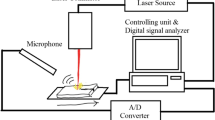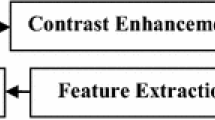Abstract
The TOFD (“Time of Flight Diffraction”) technique is being widely used for automatic weld inspection, especially in the petrochemical industry, where welding quality is essential to avoid productivity losses. Although it provides high speed inspection, high sizing reliability and low rate of false defect indications, the classification of defects using ultrasound signals generated by the TOFD technique is still frequently questioned, because it depends heavily on the knowledge and experience of the operator. However, the use of computational tools for signal preprocessing and pattern recognition, such as the artificial neural networks, improves the classification reliability of defects detected by this technique. In this present work, three kinds of defects: lack of fusion (LF), lack of penetration (LP) and porosity (PO) were inserted into the specimens durin the welding process, generating pattern defects. The position, type and dimension of each inserted defect were recorded using conventional ultrasonic and radiographic techniques. The Fourier Transform and Wavelet Transform were used for preprocessing A-scan signals acquired during weld inspection by TOFD technique. This study was able to show the versatility of Wavelet Transform to preprocess these kinds of signals, since the correct scale in Continuous Wavelet Transform had been selected to supply a neural network. Hierarchical linear classifiers were implemented into the neural network in order to distinguish the main defects in welded joints detected by the TOFD technique. The results show the good success rate of welding defect recognition in preprocessed TOFD signals, mainly using Wavelet Transform. On the whole, the results obtained were very promising and could give relevant contributions to the development of an automatic system of detection and classification of welding defects inspected by the TOFD technique.
Similar content being viewed by others
References
M. G. Silk and Idington, B. H. L “Defect sizing using an Ultrasonic Time Delay Approach,” Br. J. NDT March, pp. 33–36 (1975).
M. G. Silk, “Sizing Crack-like Defects by Ultrasonic Means,” In Research Techniques in Nondestructive Testing, Vol. 3, pp. 51–79, (1997), Academic Press, New York.
M. G. Silk, “The transfer of ultrasonic energy in the diffraction technique for crack sizing.” Ultrasonics May, pp. 113–120, (1979).
British Standard BS7706, “Guide to Calibration and Setting-up of Ultrasonic Time of Flight Diffraction (TOFD) Technique for Defect Detection, Location and Sizing of Flaws,” British Standard Institution, 1993.
A. A. A. Scheerder, “Equipment Condition Monitoring Using TOFD—Experiences at DSM,” in 15th WCNDT, 2000, Roma. Available from http://www.ndt.net/article/wcndt 00/papers /idn070/idn070.htm
A. Masnata and M. Sunseri, Neural Network Classification of Flaws Detected by Ultrasonic Means, Vol. 29, No. 2, pp. 87–93, (1996), NDT & E International.
M. H. S. Siqueira, “Long Distances Inspection Using Ultrasonic Guided Waves and Artificial Intelligence,” D.Sc. Thesis, Department of Metallurgical and Materials Engineering, COPPE/UFRJ, Brazil, 2002 (in Portuguese).
F. W. Margrave, K. Rigas, D. A. Bradley, and P. Barrowcliffe, “The use of neural networks in ultrasonic flaw detection,” Measurement 25, pp. 143–154 (1999).
J. Kim, P. Ramuhalli, L. Udpa, and S. Udpa, “Multidimensional Signal Processing for Ultrasonic Signal Classification,” Review of Progress in Quantitative Nondestructive Evaluation, edited by D. O. Thompson and D. E. Chimenti, Vol. 20, pp. 595–602, (2001), American Institute of Physics.
R. Polikar, L. Udpa, and S. S. Udpa, “Incremental Learning of Ultrasonic Weld Inspection Signals,” Review of Progress in Quantitative Nondestructive Evaluation, edited by D. O. Thompson and D. E. Chimenti, Vol. 20A, pp. 603–610, (2001), American Institute of Physics.
S. Haykin, Neural Networks, A Comprehensive Foundation, 1994, Macmillian College Publishing.
P. D. Wasserman, Neural Computing Theory and Practice, Van Nostrand Reinthold, 1989, New York.
B. P. Lathi, Communication Systems, (1968), Wiley, New York.
M. Misiti, Y. Misiti, G. Oppenheim, and J.-M. Poggi, Wavelet Toolbox for Use with MATLAB, Version 1, 1996, The MathWorks Inc.
A. L. Graps, “An introduction to Wavelets,” IEEE Comput. Sci. Eng., Vol. 2, Number 2, pp. 50–61 (1995).
C. M. Bishop, Neural Networks for Pattern Recognition, 1995, Oxford University Press.
E. P. de Moura, R. R. da Silva, M. H. S. Siqueira, and J. M. A. Rebello, “Radiographics pattern recognition of welding defects using linear classifiers .” Insight, 43 (10), pp. 669–674 (2001).
Author information
Authors and Affiliations
Corresponding author
Rights and permissions
About this article
Cite this article
Moura, E.P., Silva, R.R., Siqueira, M.H.S. et al. Pattern Recognition of Weld Defects in Preprocessed TOFD Signals Using Linear Classifiers. J Nondestruct Eval 23, 163–172 (2004). https://doi.org/10.1007/s10921-004-0822-4
Issue Date:
DOI: https://doi.org/10.1007/s10921-004-0822-4




